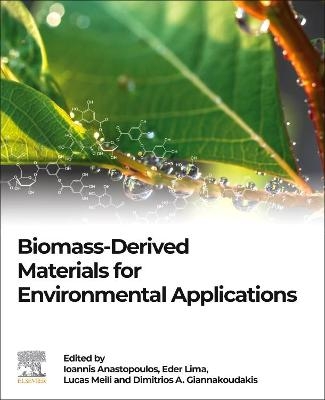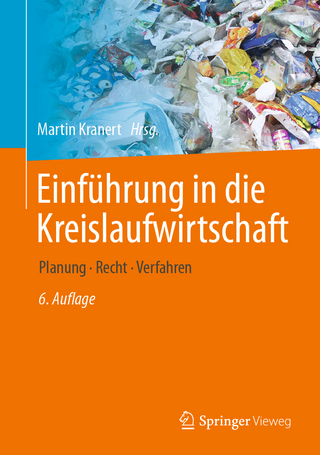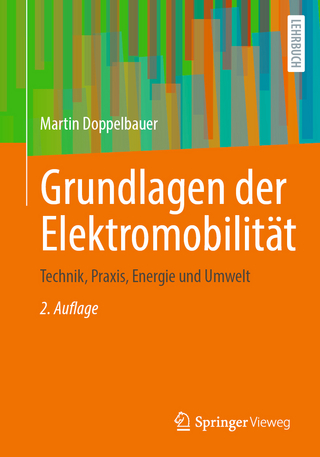
Biomass-Derived Materials for Environmental Applications
Elsevier - Health Sciences Division (Verlag)
978-0-323-91914-2 (ISBN)
Prof. Dr. Ioannis Anastopoulos is an Assistant Professor at the Department of Agriculture, University of Ioannina, Arta, Greece. His research is focused on the following areas at the estimation of greenhouse gas emissions from agricultural soils after receiving organic and inorganic materials, the fabrication of different adsorbents for wastewater treatment, and the use of organic amendments for soil remediation. He is an author of publications in peer-reviewed journals (> 70 articles) with more than 3000 citations. His name is also included in the 2% top world scientists for the year 2019 (Baas, Jeroen; Boyack, Kevin; Ioannidis, John P.A. (2020), “Data for "Updated science-wide author databases of standardized citation indicators", Mendeley Data, V2, DOI: 10.17632/btchxktzyw.2#file-dd0904a8-0eba-4cf3-be4a-c6092261fed5) Prof. Lima is a Professor of the Institute of Chemistry at the Federal University of Rio Grande do Sul. Prof Lima was editor of the Journal of Hazardous Materials from 2018 to 2020. He was an editor of the Journal of Environmental Chemical Engineering (JECE) from 2013 to 2018 and Editor of Special Issues of JECE from 2018 to 2019. Now, Prof. Lima is an editor of Microporous and Mesoporous Materials. He has more than 200 published papers. He has been working on the removal of toxic compounds from aqueous effluents using various kinds of adsorbents. His research group is now broadly focused on the use of biomass, in natural and/or chemically modified forms, for the removal of toxic species from industrial effluents; the development of new adsorbent materials such as organo-functionalized silica and silicates, celluloses, and carbon nanotubes; and the production of new activated carbons derived from renewable sources. Lucas Meili is Professor in the Center of Technology at the Federal University of Alagoas, Maceió, Brazil. His areas of interest are focused in separation processes, water and wastewater treatment, and synthesis of materials, with a particular interest in adsorption and advanced oxidation processes. Dr. Dimitrios Giannakoudakis graduated as chemist from Aristotle University of Thessaloniki (AUTh) in Greece, where he obtained also two M.Sc. degrees (in Physical-chemistry & Electrochemistry and in New Educational Technologies). He received his PhD degree on “Nanotechnology and Materials Chemistry from the City University of New York (CUNY) with full scholarship, in 02/2017. Then, he continued as postdoctoral-fellow and adjunct tutor at the City College of New York, AUTh, and the Institute of Physical Chemistry (IChF) of Polish Academy of Sciences. Afterwards, he served at IChF as adj. Assistant Professor and tutor of “Modern nano-Topics in Physical Chemistry. Currently, he is Research Associate and tutor at AUTh. He has co-authored more than 105 publications in leading peer-reviewed journals (avg. Impact Factor as 1st author above 11), with the articles to be cited more than 3000 times, one monograph by Springer, three edited books by Elsevier, more than 20 book chapters, and 3 invention patents. For more details: www.DaGchem.com
1. (Radio)toxic metal ion adsorption by plant fibers
2. The Utilisation of Rubber (Hevea brasiliensis) Seed Shells as Adsorbent for Water Pollution Remediation
3. Biochar for the Removal of Methylene Blue from Aquatic Environment: A Review
4. Application of biochar to abate soil pollution
5. Biomass-Derived Adsorbents for Caffeine Removal From Aqueous
6. Carbonaceous materials - A prospective strategy for eco-friendly decontamination of wastewater
7. Production of carbon-based adsorbents from lignocellulosic biomass
8. Lignin and Lignin-Derived Products As Adsorbent Materials For Wastewater Treatment has been
9. Utilization of mussel shell to remediate soils polluted with heavy metals
10. Perspectives of the reuse of agricultural wastes from Rio Grande do Sul, Brazil, as new adsorbent materials
11. Polyvalent metal ion adsorption by chemically modified biochar fibers
12. Leucaena Leucocephala as biomass material for Heavy Metals and Metalloids removal
13. Sunflower-based materials for environmental application
14. A review of pine-based adsorbents for the adsorption of dyes
15. Utilisation of avocado (Persea americana) adsorbents for the elimination of pollutants from water: A review
16. Agro-wastes as precursors of biochar, a cleaner adsorbent to remove pollutants from aqueous
17. Biomass-derived renewable materials for sustainable chemical and environmental applications
| Erscheinungsdatum | 06.06.2022 |
|---|---|
| Zusatzinfo | Approx. 200 illustrations; Illustrations |
| Verlagsort | Philadelphia |
| Sprache | englisch |
| Maße | 191 x 235 mm |
| Gewicht | 950 g |
| Themenwelt | Naturwissenschaften ► Biologie ► Ökologie / Naturschutz |
| Technik ► Umwelttechnik / Biotechnologie | |
| ISBN-10 | 0-323-91914-6 / 0323919146 |
| ISBN-13 | 978-0-323-91914-2 / 9780323919142 |
| Zustand | Neuware |
| Informationen gemäß Produktsicherheitsverordnung (GPSR) | |
| Haben Sie eine Frage zum Produkt? |
aus dem Bereich


